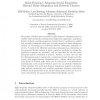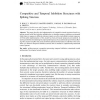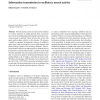23 search results - page 2 / 5 » Clustering neural spike trains with transient responses |
NECO
2007
13 years 4 months ago
2007
We propose a Markov process model for spike-frequency adapting neural ensembles which synthesizes existing mean-adaptation approaches, population density methods, and inhomogeneou...
NPL
2000
13 years 4 months ago
2000
The paper describes the implementation of competitive neural structures based on a spiking neural model that includes multiplicative or shunting synapses enabling non-saturated sta...
EVOW
2001
Springer
13 years 9 months ago
2001
Springer
Abstract. We describe a set of preliminary experiments to evolve spiking neural controllers for a vision-based mobile robot. All the evolutionary experiments are carried out on phy...
BC
2008
13 years 5 months ago
2008
Periodic neural activity not locked to the stimulus or to motor responses is usually ignored. Here, we present newtoolsformodelingandquantifyingtheinformationtransmission based on ...
NIPS
2004
13 years 6 months ago
2004
Experimental studies have observed synaptic potentiation when a presynaptic neuron fires shortly before a postsynaptic neuron, and synaptic depression when the presynaptic neuron ...



